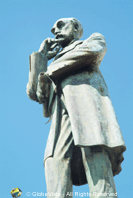C.Y.O’Connor Statue

Public Art: C.Y.O’Connor Statue
Sculptor: © Pietro Porcelli
Date Unveiled: On June 23rd, 1911, the statue was unveiled by the Governor, Sir Gerald Strickland.

Description of the C.Y.O’Connor statue: A 12 feet memorial to the one of Australia’s greatest engineers, C.Y. O’Connor (11 January 1843 – 10 March 1902). O’Connor was behind the building of Fremantle Harbour and the Goldfields Pipeline project. The 3.2m bronze statue of C.Y. O’Connor depicts the great engineer standing high on a granite plinth deep in thought, with the right hand under his chin and a set of plans rolled up in his left hand. The statue is layered with meanings and interpretations. Looking over the Fremantle Harbour he so successfully created, it is hard not to wonder of all the achievements Western Australia was denied, due to C.Y.O’Connor’s unexpected death. A man who worried about general opinion and who struggled with the press, Porcelli has captured not only O’Connor’s intellectual side but also his quiet vulnerability, all the things that were and all the things that could have been. At the base of the plinth can be found four bronze dolphins and each side bears a copper plaque depicting his greatest achievements; the Mundaring Weir, the Goldfields Pipeline Scheme, Fremantle harbour and the Swan River Tunnel through the Darling Range.
Location: The original location of the O’Connor statue was in front of the Harbour Trust Offces but was later moved in 1974-1975 to its present location outside the Port Authority Building, Victoria Quay, Fremantle, Western Australia.
Background to C.Y. O’Connor: It would be fair to say that C.Y.O’Connor was an engineering genius. Charles Yelverton O’Connor was brought to Western Australia by the newly appointed first Premier of WA, John Forrest, in 1891, to take up the role of Engineer-in-Chief.
His first major project was the rebuilding of the Fremantle Harbour, which had been an engineering nightmare, due to the rocky bar blocking the mouth of the Swan River. His solution was to simply blow it up and placed two stone moles at the entrance to stop sand entering the harbour, problem solved.
But, undeniably his greatest achievement was the building of the Goldfields Pipeline Scheme. A plan that was initially scoffed at. Can you imagine proposing to build a £2.5 million pipeline that pumps 5 million gallons of water a day, some 530kms, to a town short of water (in 1896!)? Crazy you might say, but he did it and it was done on time to boot. Sadly, however, O’Connor would never get to see his greatest achievement completed.
On the 10th of March, 1902, whilst riding his horse along a stretch of isolated beach near Fremantle, O’Connor entered the water, near Robbs Jetty, and shot himself. Many believed that the years of criticism from politicians, press and peers had taken its toll. Click here for more information on C.Y O’Connor.
The history behind the C.Y. O’Connor Statue: Five years after the untimely death of C.Y.O’Connor the Fremantle Chamber of Commerce proposed that a statue be erected to honour the great civil engineer. It wasn’t long before a Memorial Committee was formed and fundraising started. Local Governments and citizens from near and far contributed to the funds, raising a total of £1600. The committee then announced an Australia wide competition for design. The winner was Italian born Pietro Porcelli, who was amongst the 17 entrants. The statue was unveiled on the 23rd of June, 1911, by the then Governor, Sir Gerald Strickland. Following the unveiling, Sir John Forrest was quoted as saying it was a “thinking in Bronze”.
Myths About C.Y.O’Connor’s Death: Despite popular belief, C.Y.O’Connor did not take his life because he thought that the water had failed to reach Kalgoorlie on the expected time. Nor did he shoot himself just as the first drops of water trickled out. O’Connor died a year before the completion of the pipeline.
According to Bibbulmum legend, O’Connor took his life because he had been cursed by traditional Aboriginals. In a ceremony, known as being “sung” to death, members of several clans, who were angry at the removal of the limestone bar in the Fremantle Harbour, chanted a song that sent negative energy to him.
Interesting Points to Note : Sculptor Pietro Porcelli was paid £3,000 for his commission.
Other Related C.Y.O’Connor Memorials: Horse and Rider Monument and C.Y.O’Connor Bust.